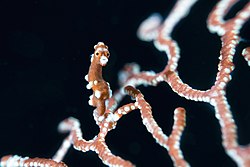Biology:Denise's pygmy seahorse
| Denise's pygmy seahorse | |
|---|---|

| |

| |
| at Raja Ampat | |
| Scientific classification | |
| Domain: | Eukaryota |
| Kingdom: | Animalia |
| Phylum: | Chordata |
| Class: | Actinopterygii |
| Order: | Syngnathiformes |
| Family: | Syngnathidae |
| Genus: | Hippocampus |
| Species: | H. denise
|
| Binomial name | |
| Hippocampus denise Lourie & Randall, 2003
| |
Hippocampus denise, also known as Denise's pygmy seahorse[3] or the yellow pygmy seahorse, is a seahorse of the family Syngnathidae native to the western Pacific.
Description
Denise's pygmy seahorse is a small fish which can reach a maximum length of approximately 2.4 cm, which makes it one of the smallest representatives of the seahorses.[4] This pygmy seahorse has a short snout, slender body with a prehensile tail. Its body is either completely smooth or provided with some polyp-like tubercles, in which case these are fewer and less developed than Hippocampus bargibanti. Its coloration ranges from yellow, more or less bright, to orange with often small dark spots and sometimes darker bands on the tail.[5]
Distribution and habitat
This pygmy seahorse has been reported from several locations in the western Pacific, including Indonesia, Vanuatu, Palau, Malaysia, the Solomon Islands and Micronesia. It can be found at depths between 13 and 100 m, generally hiding in fields of gorgonians (e.g., Annella, Muricella and Echinogorgia).[4][5]
Biology
Denise's pygmy seahorse uses adaptive camouflage, changing its color to match that of the surrounding gorgonians.[4] It feeds on small crustaceans and other zooplankton.[6] An individual will stay on a single coral for the duration of its entire life. The species is ovoviviparous, and it is the male who broods the eggs in its ventral brood pouch. The latter includes villi rich in capillaries that surround each fertilized egg creating a sort of placenta supplying the embryos. When fully grown, pups are expelled from the pocket and become autonomous.[5] Males have been recorded as giving birth to 6-7 pups after 11 days of gestation, and carrying out four sequential pregnancies of the same gestation length.[7]
Conservation status
The species is relatively rare and only few data relating to the population as well as its actual distribution exist. Because of this lack of information and the rarity of the species, Denise's pygmy seahorse is currently classified as Data Deficient by the IUCN.[1] Internationally, it is also listed in Appendix II of the Convention on International Trade in Endangered Species of Wild Fauna and Flora (CITES) this means that it is on the list of species not necessarily threatened with extinction, but in which trade must be controlled in order to avoid utilization incompatible with their survival.[1]
Naming
The common name and the specific name honour the diver and underwater photographer Denise Tackett, who died in 2015; she was diving with Sara Lourie, one of the describers of H. denise, when she first encountered this species in the Lembeh Strait in 1999.[8]
References
- ↑ 1.0 1.1 1.2 Kuo, T.-C.; Pollom, R. (2017). "Hippocampus denise". IUCN Red List of Threatened Species 2017: e.T41716A54909161. doi:10.2305/IUCN.UK.2017-3.RLTS.T41716A54909161.en. https://www.iucnredlist.org/species/41716/54909161. Retrieved 14 November 2021.
- ↑ "Appendices | CITES". https://cites.org/eng/app/appendices.php.
- ↑ Scales, Helen (2009). Poseidon's Steed: The Story of Seahorses, From Myth to Reality. Penguin Publishing Group. p. 136. ISBN 978-1-101-13376-7. https://books.google.com/books?id=4Wifibfq2rMC&pg=PT136. Retrieved 9 June 2019.
- ↑ 4.0 4.1 4.2 Froese, Rainer and Pauly, Daniel, eds. (2015). "Hippocampus denise" in FishBase. 10 2015 version.
- ↑ 5.0 5.1 5.2 Lourie, S.A.; Randall, J.E. (2003). "A New Pygmy Seahorse, Hippocampus denise (Teleostei: Syngnathidae), from the Indo-Pacific". Zoological Studies 42 (2): 284–291.
- ↑ "Denise' Pygmy Seahorse, Hippocampus denise Lourie & Randall 2003". Fishes Of Australia. http://www.fishesofaustralia.net.au/home/species/4772#moreinfo.
- ↑ Smith, R. E.; Tibbetts, I. R. (2008). "Mating and birth of Denise's pygmy seahorses (Hippocampus denise) observed in the wild". Coral Reefs 27 (3): 617. doi:10.1007/s00338-008-0373-8.
- ↑ Sara Lourie (12 January 2016). "In memory of Denise Tackett". Project Seahorse. http://www.projectseahorse.org/blog/2016/1/12/in-memory-of-denise-tackett.
External links
| Wikimedia Commons has media related to Hippocampus denise. |
- Photos of Denise's pygmy seahorse on Sealife Collection
Wikidata ☰ Q1187728 entry
 |


